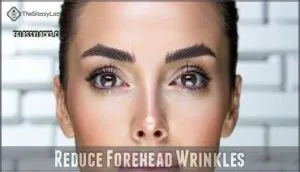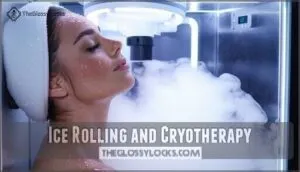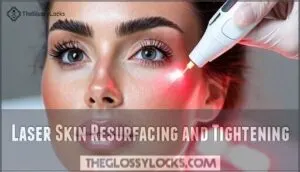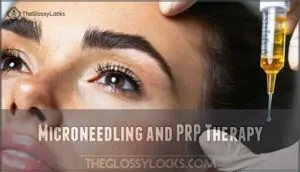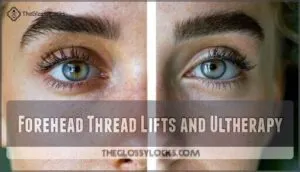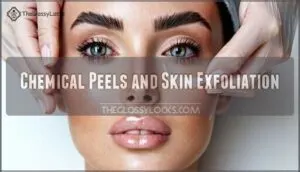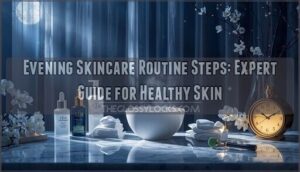This site is supported by our readers. We may earn a commission, at no cost to you, if you purchase through links.

Start with daily sunscreen use and moisturizing to protect against UV damage and maintain skin hydration. Retinoids are your best friend for boosting collagen production, while staying hydrated and getting quality sleep helps your skin repair itself.
Professional options like Botox temporarily relax wrinkle-causing muscles, while chemical peels and microneedling stimulate skin renewal. Even simple facial massages can improve circulation and skin texture.
The key is consistency—your forehead didn’t develop these lines overnight, and they won’t disappear that quickly either. But with the right approach, you’ll discover techniques that work surprisingly well. The use of retinoids and maintaining skin hydration are crucial for effective results.
Table Of Contents
- Key Takeaways
- Causes of Forehead Wrinkles
- Reduce Forehead Wrinkles
- Preventing Forehead Wrinkles
- Professional Treatments Available
- At-Home Remedies and Devices
- Non-Surgical Forehead Wrinkle Reduction
- Maintaining Smooth Forehead Skin
- Frequently Asked Questions (FAQs)
- How to reduce wrinkles from the forehead naturally?
- Does vitamin C get rid of forehead wrinkles?
- What tightens forehead wrinkles?
- Can forehead wrinkles be completely reversed?
- What age do forehead wrinkles typically appear?
- Are mens forehead wrinkles different than womens?
- Do forehead wrinkles indicate underlying health issues?
- Can certain medications cause forehead wrinkles?
- Conclusion
Key Takeaways
- Start with daily sunscreen and moisturizer – You’ll prevent 80% of skin aging by applying SPF 30+ every morning and keeping your skin hydrated, which protects against UV damage that breaks down collagen.
- Use retinoids consistently at night – You’ll see measurable improvements in 8-12 weeks by applying retinol or prescription retinoids, which boost collagen production and reduce wrinkle depth by up to 30%.
- Consider professional treatments for faster results – You can achieve dramatic improvements with Botox injections (lasting 3-4 months), chemical peels, or laser treatments that cost $200-1,000 per session.
- Maintain results with lifestyle changes – You’ll preserve your progress by staying hydrated, getting 7-9 hours of sleep, managing stress, and avoiding smoking and excessive drinking that accelerate skin aging.
Causes of Forehead Wrinkles
Understanding what causes forehead wrinkles helps you target the right solutions for smoother skin.
Your forehead develops these lines through a combination of natural aging processes, daily habits, and environmental factors that break down your skin’s supportive structure over time, which can be considered as natural aging processes and daily habits.
Your skin ages faster when daily habits team up with time to break down what keeps you looking young.
Aging and Skin Elasticity
Aging fundamentally transforms your skin’s architecture, creating the perfect storm for forehead wrinkles.
As you age, collagen decline accelerates while elastin loss reduces skin elasticity, making your forehead vulnerable to permanent creasing.
Genetic factors determine when this skin aging process begins, but lifestyle influence and hydration impact can either accelerate or slow these antiaging concerns substantially.
Repeated Muscle Movements
Your face tells a story through repeated muscle movements. Every time you raise your eyebrows, squint, or frown, you’re training those frontalis muscles to create lasting expression lines through muscle memory.
- Facial expressions like surprise or concentration repeatedly contract forehead muscles, creating dynamic wrinkles that eventually become permanent
- Frontalis activity from habitual eyebrow raising builds muscle memory, deepening horizontal lines across your forehead over time
- Frowning effects from stress or concentration create vertical worry lines between your brows, contributing to overall forehead aging
A good way to combat this is with a consistent skincare routine.
UV Exposure and Sun Damage
Throughout your day, UV radiation works like a silent thief, stealing your skin’s youthful appearance.
Sun damage accelerates collagen breakdown, creating premature aging that shows up as forehead wrinkles.
Tanning beds intensify this damage, making sunscreen efficacy essential for protection.
| UV Exposure Source | Collagen Impact | Prevention Method |
|---|---|---|
| Direct sunlight | Breaks down 80% faster | SPF 30+ daily |
| Tanning beds | 10-15x more damage | Complete avoidance |
| Reflected UV (water/snow) | Doubles exposure risk | Broad-spectrum protection |
Genetics and Lifestyle Habits
Beyond sun exposure, your genetics and lifestyle habits play major roles in forehead wrinkles development.
Your genetic predisposition determines when skin aging starts, while daily choices accelerate or slow the process.
Here’s how genetics and lifestyle habits affect your skin:
- Genetic Predisposition – Your family history influences collagen production rates and when static wrinkles appear
- Smoking Effects – Cigarettes reduce collagen production and damage skin elasticity, deepening forehead wrinkles
- Alcohol Consumption – Excessive drinking dehydrates skin and accelerates aging through inflammation
- Hydration Impact – Poor water intake affects skin plumpness, making wrinkles more visible and pronounced
Sleep quality also matters substantially.
Poor rest disrupts skin repair processes, while adequate sleep promotes cellular regeneration.
These lifestyle habits work together – smoking while drinking and staying dehydrated creates a perfect storm for premature skin aging.
Your genetics set the baseline, but your daily choices determine how quickly wrinkles prevention becomes necessary.
External Factors and Pollution
Environmental pollutants act like invisible enemies against your skin, accelerating forehead wrinkles through constant exposure.
Your skin battles invisible pollutants daily, quietly stealing its youthful glow.
Urban environments bombard you with toxins that create free radicals, breaking down collagen faster than your body can repair it.
Pollution exposure combines with UV radiation to double skin aging acceleration, and daily sunscreen becomes your shield against these environmental stressors, acting as a protective measure to combat free radicals.
Reduce Forehead Wrinkles
If you’re tired of looking in the mirror and seeing those horizontal lines across your forehead, you’re not alone.
The good news is that reducing forehead wrinkles is entirely possible with the right combination of preventive measures, skincare routines, lifestyle changes, and stress management techniques.
Preventive Measures and Lifestyle Changes
Since bad habits can fast-track skin aging acceleration, you’ll want to establish protective lifestyle habits early.
Start with SPF daily application—even on cloudy days—to prevent forehead wrinkles from UV damage.
Stay hydrated and maintain a balanced diet rich in antioxidants.
Consider retinol incorporation for nighttime routines and vitamin C benefits for morning protection.
These simple changes address forehead wrinkle causes before they become permanent fixtures.
Skincare Routines and Product Usage
Creating an effective skincare routine becomes your secret weapon against forehead wrinkles when you choose the right products and timing.
Transform your skin with these three powerhouse strategies:
- Retinoid Application at night – This antiaging moisturizer boosts collagen production while you sleep
- Peptide Serums morning and evening – These peptideinfused skincare heroes plump and smooth your skin
- Consistent Cleansing followed by Sunscreen Reapplication – Your daily defense against environmental damage
Your nighttime routines matter most for forehead wrinkle reduction, so don’t skip that retinol step!
Maximize benefits with proper product selection.
Dietary Habits and Hydration
What you eat directly impacts your skin’s ability to fight wrinkles.
A balanced diet rich in antioxidant foods like berries and leafy greens supports collagen boosting while reducing inflammation.
Limit sugar intake since it accelerates skin aging through glycation.
Stay hydrated—proper hydration benefits include maintaining skin moisture and elasticity.
Hyaluronic acid benefits include plumping the skin.
Your healthy diet choices become your skin’s best defense against premature aging with the help of a balanced diet and proper hydration.
Managing Stress and Sleep
High-quality stress reduction techniques and consistent sleep patterns directly impact your skin’s ability to repair itself overnight.
Chronic stress triggers cortisol release, which breaks down collagen and accelerates forehead wrinkles formation.
Prioritize seven to nine hours of quality sleep nightly, practice relaxation techniques like deep breathing or meditation, and maintain consistent bedtimes.
Your mental wellbeing reflects in your skin care results—when you’re well-rested and calm, your healthy lifestyle choices become more sustainable and effective, leading to better skin care and a more healthy lifestyle.
Preventing Forehead Wrinkles
You can’t prevent wrinkles entirely, but you can substantially slow their formation with the right protective habits.
Starting these prevention strategies early gives you the best chance of maintaining smooth forehead skin for years to come.
Daily Sunscreen Application
With daily SPF broad-spectrum sunscreen application, you’re building your strongest defense against UV radiation that breaks down collagen.
Choose SPF 30 or higher with zinc oxide or titanium dioxide ingredients for maximum skin protection.
Apply every morning and reapply every two hours during sun exposure for effective skin cancer prevention.
Wearing Protective Gear
Beyond applying sunscreen, you’ll want to shield your face with Sun Protective Hats and UV Blocking Visors that create physical barriers against harmful rays.
Glare Reducing Sunglasses protect the delicate eye area while preventing squinting that deepens forehead lines.
Choose Protective Clothing Material with tight weaves for maximum coverage, and follow Gear Maintenance Tips to guarantee your skin headwear remains effective against UV radiation.
Avoiding Harsh Chemicals
Your skin deserves better than harsh chemicals that can worsen forehead wrinkles.
Swap aggressive products for gentle exfoliation methods and natural ingredients. Choose toxin-free products and organic skincare options that nourish rather than strip your skin.
DIY alternatives using simple ingredients often work better than commercial forehead wrinkle creams. The best antiaging forehead skincare focuses on natural forehead wrinkle remedies that support your skin’s health.
Regularly moisturizing helps to keep skin hydrated and minimize the appearance of wrinkles, which is a key part of a natural skincare routine that promotes healthy skin and reduces wrinkles.
Maintaining a Balanced Diet
When you fuel your body with the right nutrients, you’re basically feeding your skin from the inside out.
A balanced diet rich in antioxidants and collagen boosters can substantially impact your skin’s ability to maintain elasticity and fight wrinkles.
- Antioxidant Intake: Load up on berries, leafy greens, and colorful vegetables to combat free radical damage
- Collagen Boosters: Include vitamin C-rich foods like citrus fruits and bell peppers for natural collagen production
- Hydration Importance: Drink plenty of water and eat water-rich foods to maintain ideal skin hydration
- Sugar Reduction: Cut back on refined sugars that accelerate skin aging and break down collagen fibers
Professional Treatments Available
When at-home remedies aren’t enough, you’ll find professional treatments offer more dramatic and longer-lasting results for forehead wrinkles.
These medical procedures range from quick injections to advanced laser technologies, with costs typically between $200 to $1,000 per session depending on the treatment complexity.
Surgical Facelifts and Rhytidectomy
When prevention isn’t enough, surgical facelifts and rhytidectomy offer dramatic, long-lasting results.
These procedures target deep forehead creases by repositioning underlying tissues and tightening skin.
While surgical risks include scarring outcomes and infection, facelift longevity spans 8-15 years.
The recovery process requires 2-4 weeks downtime, but rhytidectomy techniques deliver thorough rejuvenation that non-surgical treatments can’t match.
Many patients also choose to address aging signs with a standard facelift procedure.
Neuromodulators and Botox Injections
Botox injections deliver targeted relief by temporarily paralyzing forehead muscles responsible for dynamic wrinkles.
These neuromodulators—including Dysport, Xeomin, and Jeuveau—block nerve signals at specific injection sites, smoothing lines for three to four months.
You’ll notice results within days, though potential side-effects like bruising or headaches may occur.
Explore options for Botox wrinkle products to complement your treatment.
Treatment duration varies based on individual muscle strength and desired outcomes.
Hyaluronic Acid Fillers and Laser Treatments
Beyond neuromodulators, hyaluronic acid fillers offer immediate volume restoration for deeper forehead wrinkles, with filler longevity lasting 6-18 months.
Laser treatments like Fraxel stimulate collagen production over multiple sessions.
Treatment costs range from $200-600 for fillers and $350-1,000+ for laser types.
Recovery process involves minimal downtime for fillers, while potential risks include bruising and swelling.
However, note that no fillers are FDA-approved for forehead use, which is a significant consideration for treatment risks.
Chemical Peels and Microcurrent Facials
Chemical peels target hyperpigmentation and fine lines, while microcurrent facials enhance skin tone and circulation.
These treatments work together to smooth forehead wrinkles effectively.
For those seeking at-home solutions, consider exploring various peel products.
- Peel strengths vary from light glycolic acid to deeper TCA peels for different skin types
- Microcurrent benefits include improved lymphatic drainage and enhanced collagen production
- Treatment frequency typically ranges from monthly peels to weekly microcurrent sessions
- Expected results show gradual wrinkle reduction with consistent professional facial treatments
At-Home Remedies and Devices
Professional treatments aren’t your only option for smoothing forehead wrinkles.
You can achieve noticeable results from your own home using proven devices and techniques that stimulate collagen production and improve skin texture.
Ice Rolling and Cryotherapy
Ice rolling benefits your forehead by stimulating lymphatic drainage and reducing puffiness naturally.
This at-home cryo technique constricts blood vessels, helping reduce forehead lines while tightening skin.
DIY cryotherapy alternatives like specialized ice tools offer convenient skin wrinkles cryotherapy without expensive treatments.
Regular cryotherapy ice rolling sessions can soften fine lines effectively.
Facial Cupping and Massaging
Facial cupping and massaging offer powerful cupping benefits for forehead wrinkles through gentle suction that promotes lymphatic drainage and collagen stimulation.
These massage techniques increase blood circulation, helping reduce skin wrinkles while facial cupping systems encourage cellular repair.
At-home tools like facial massage devices make forehead wrinkle massage accessible, supporting natural skin rejuvenation without expensive treatments, and can be considered a form of lymphatic drainage.
Using Retinoids and Peptide Serums
Since retinoids boost collagen production and peptides strengthen your skin barrier, you’ll see measurable improvements in forehead wrinkles within 8-12 weeks of consistent use.
Transform your skin care routine with these powerful ingredients:
- Retinoid Benefits: FDA-approved wrinkle fighters that reduce depth by up to 30%
- Peptide Types: Collagen-stimulating formulas that repair and firm aging skin
- Serum Application: Night retinoids paired with morning peptides maximize antiaging results
- Product Combinations: Layer moisturizers with retinoids to prevent irritation and dryness
- Expected Results: Smoother, more elastic skin texture becomes visible after consistent treatment
DIY Skincare and Self-Care Routines
Beyond products, establishing proper DIY skincare and self-care routines creates lasting results.
Incorporate facial massage techniques to boost circulation and stimulate collagen production. Switch to silk pillowcases and adjust sleep positions to prevent sleep lines.
Maintain consistent cleansing routines and hydration habits. These forehead wrinkle exercises and antiaging routine practices complement your microneedling forehead wrinkles treatment for thorough forehead wrinkle treatment results, which can be enhanced by facial massage techniques and proper DIY skincare.
Non-Surgical Forehead Wrinkle Reduction
If you’re looking for effective ways to smooth forehead wrinkles without surgery, several proven non-surgical treatments can help you achieve younger-looking skin.
These advanced procedures work by stimulating your skin’s natural healing processes, targeting wrinkles at their source while requiring minimal downtime, and this process helps in achieving a smoother skin by stimulating your skin’s natural healing processes.
Laser Skin Resurfacing and Tightening
Looking beyond at-home solutions, laser skin resurfacing and laser skin tightening deliver professional-grade skin rejuvenation.
These laser types target forehead wrinkles through controlled heat, stimulating collagen production for smoother skin.
Treatment downtime varies from days to weeks, while procedure cost ranges $350-$1,000+ per session.
Expected results include improved texture and reduced lines, though risks/side effects like redness may occur temporarily.
Microneedling and PRP Therapy
Microneedling creates controlled micro-injuries that trigger your skin’s natural healing response, boosting collagen production by up to 400%.
When combined with PRP therapy, which uses your own platelets for cellular repair, you’ll see 50-65% improvement in forehead wrinkles.
Most people need 3-6 sessions spaced 4-6 weeks apart for ideal skin rejuvenation and recovery process.
Forehead Thread Lifts and Ultherapy
Thread lifts and Ultherapy offer non-surgical skin tightening alternatives to traditional facelift procedures.
These treatments target forehead wrinkles through different mechanisms, with thread lifts providing immediate mechanical lifting while Ultherapy uses focused ultrasound energy for gradual collagen stimulation.
Procedure Comparison Benefits:
- Thread lift risks remain minimal with proper technique – expect temporary swelling and bruising lasting 1-2 days
- Ultherapy effectiveness shows 80% patient satisfaction with FDA-cleared skin lifting lasting up to one year
- Recovery timeline differs substantially – threadlifting offers immediate results while Ultherapy develops over 2-3 months
- Cost analysis varies by provider, with both treatments requiring no general anesthesia or surgical incisions
- Skin tightening results from dissolvable sutures in thread lifts versus deep ultrasound energy in Ultherapy treatments
The key differences between thread lifts and Ultherapy lie in their approach to skin tightening, with thread lifts using mechanical means and Ultherapy relying on ultrasound energy to stimulate collagen production.
Chemical Peels and Skin Exfoliation
Chemical peels offer targeted treatment for forehead wrinkles through controlled skin exfoliation.
Glycolic acid and other alpha hydroxy acids remove damaged surface layers, while beta hydroxy acids penetrate deeper.
Treatment frequency depends on peel strength—light peels weekly, medium peels monthly.
Chemical safety requires professional assessment, and post-peel care includes gentle cleansing and sun protection for ideal healing.
Maintaining Smooth Forehead Skin
Once you’ve tackled your forehead wrinkles with treatments, maintaining smooth skin becomes your ongoing mission.
The key lies in building consistent daily habits that protect and nourish your skin, preventing new wrinkles from forming while preserving the results you’ve worked hard to achieve, which is crucial for maintaining consistent daily habits.
Consistent Skincare and Sunscreen Usage
Your skin care routine becomes your first line of defense against forehead wrinkles when you make it a daily habit.
Daily SPF application protects against UV damage that breaks down collagen, while routine cleansing removes pollutants that accelerate aging.
Product ingredients like retinol and vitamin C boost collagen production, and proper hydration importance can’t be overstated for maintaining elasticity.
Regular exfoliation benefits include removing dead skin cells that emphasize lines.
Healthy Lifestyle Choices and Stress Management
Your lifestyle choices can make or break your skin’s resilience against forehead wrinkles.
Stress reduction through meditation or yoga helps prevent chronic muscle tension that deepens lines.
A balanced diet rich in antioxidants supports collagen production, while adequate sleep allows cellular repair.
Regular hydration habits keep skin plump and elastic.
Exercise benefits include improved circulation and natural stress management, creating a foundation for effective skin care routines.
Avoiding Smoking and Excessive Drinking
Beyond managing stress levels, breaking harmful habits like smoking and excessive drinking directly impacts your skin’s ability to maintain its youthful appearance.
These lifestyle choices create a domino effect that accelerates aging and deepens forehead wrinkles.
Here’s how these habits damage your skin:
- Smoking Effects – Reduces collagen production by up to 40% and restricts blood flow to facial tissues
- Alcohol Impact – Dehydrates skin cells and depletes essential vitamins needed for skin repair
- Collagen Production – Both habits interfere with your body’s natural collagen synthesis process
- Skin Elasticity – Toxins break down elastin fibers, causing skin to lose its bounce-back ability
- Aging Acceleration – Combined effects can age your skin 10-15 years faster than normal
Making these lifestyle changes supports your skin’s natural repair mechanisms and enhances the effectiveness of other wrinkle prevention strategies.
Getting Adequate Sleep and Staying Hydrated
Why sacrifice beauty sleep when it’s your skin’s best friend? Quality rest and proper hydration work together to maintain skin elasticity and reduce forehead wrinkles.
During sleep, your body performs cellular repair, boosting collagen production and skin plumpness.
| Sleep Quality Benefits | Hydration Benefits | Combined Effects |
|---|---|---|
| Cellular repair processes | Maintains skin elasticity | Reduces puffiness |
| Collagen production boost | Improves skin plumpness | Smoother forehead texture |
| Stress hormone reduction | Flushes out toxins | Enhanced skin hydration |
Aim for 7-9 hours nightly while drinking plenty of water throughout the day.
Your forehead will thank you with fewer lines and better skin hydration methods working naturally.
Frequently Asked Questions (FAQs)
How to reduce wrinkles from the forehead naturally?
Forehead wrinkles can appear as early as your 20s, but you can naturally reduce them through daily SPF 30+ sunscreen, retinol treatments, vitamin C serums, staying hydrated, and avoiding repetitive facial expressions.
Does vitamin C get rid of forehead wrinkles?
Vitamin C boosts collagen production and protects against UV damage, which helps reduce fine lines over time.
However, it won’t eliminate deep forehead wrinkles alone—you’ll need consistent use with other treatments.
What tightens forehead wrinkles?
Prevention is better than cure," but when forehead wrinkles already exist, you’ll need targeted treatments.
Botox injections, retinoids, laser resurfacing, and dermal fillers effectively tighten skin by stimulating collagen production and relaxing underlying muscles.
Can forehead wrinkles be completely reversed?
While you can’t completely reverse forehead wrinkles, you can substantially reduce their appearance through professional treatments like Botox, fillers, and laser resurfacing combined with consistent skincare routines.
What age do forehead wrinkles typically appear?
You’ll likely notice those first lines creeping in during your twenties or thirties, though some people see them earlier depending on genetics and facial expressions.
Are mens forehead wrinkles different than womens?
Men’s forehead muscles are about 40% stronger than women’s, creating deeper, more pronounced horizontal lines.
However, the fundamental wrinkle formation process remains identical between genders – repetitive muscle contractions combined with collagen loss.
Do forehead wrinkles indicate underlying health issues?
Forehead wrinkles typically don’t signal serious health problems—they’re usually just signs of natural aging, sun damage, or frequent facial expressions. However, sudden changes warrant checking with your doctor.
Can certain medications cause forehead wrinkles?
Like shadows on a clock face, some medications cast subtle changes across your skin’s surface.
While most drugs don’t directly cause wrinkles, certain steroids and blood thinners can affect collagen production, potentially accelerating skin aging.
Conclusion
Successfully smoothing stubborn forehead wrinkles requires dedication and the right approach.
You’ve learned how to reduce forehead wrinkles through proven methods ranging from daily sunscreen protection to professional treatments like Botox and chemical peels.
Remember that consistency matters most—combine preventive measures with targeted treatments for the best results.
Whether you choose at-home remedies or professional procedures, patience and persistence will help you achieve the smoother, more youthful forehead you desire.

